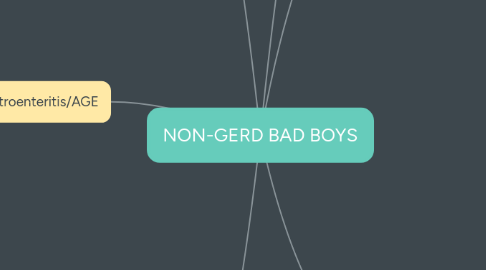
1. Pyloric Stenosis
1.1. pyloric sphincter becomes thickened & restricts gastric outlet
1.2. Clinical features:
1.2.1. presents around 4-6 weeks
1.2.2. forceful/projectile vomiting after feeds
1.2.3. infant loses weight, appears hungry
1.2.4. "olive" 1-2cm mobile, non-tender mass RUQ
1.3. Diagnosis
1.3.1. Hx, BMP, pyloric US
1.3.2. Hypochloremic metabolic alkalosis(-HCl)
1.4. Management
1.4.1. requires surgery (pyloromyotomy)
2. Malrotation/Volvulus
2.1. incomplete rotation of embryonic gut in 8-10th week of fetal development
2.2. midgut can rotate & cause Volvulus (obstruction)
2.3. Clinical features:
2.3.1. ill appearing, pain, distention, BILIOUS EMESIS
2.4. Diagnosis
2.4.1. UPPER GI STUDY w/ CONTRAST
2.5. Manamement
2.5.1. a surgical emergency!
3. Intusussception
3.1. telescoping of ileum into ascending colon
3.2. Clinical features:
3.2.1. aged 6-36months
3.2.2. recurrent crampy abdominal pain q 15-20minutes
3.2.3. vomiting (can be bilious), blood is stool (50%) CURRANT JELLY STOOL, lethargy
3.3. Diagnosis
3.3.1. abdominal US
3.4. Treatment
3.4.1. pneumatic (air) enema
3.4.2. sometimes surgery
4. Acute Gastroenteritis/AGE
4.1. clinical features
4.1.1. > or = 3 watery stools daily(or more than 2 stools over usual daily pattern)
4.1.2. intermittent fever, abd. pain, N/V, diarrhea, fatigue, dehydration
4.1.3. duration usually < a week
4.2. Etiology:
4.2.1. Majority VIRAL (Rotavirus/vaccine avail.)
4.2.2. can be bacterial or parasitic
4.3. diagnosis
4.3.1. typically clinical diagnosis, NO labs
4.3.2. Consider:
4.3.2.1. ELECTROLYTES (if dehydrated)
4.3.2.2. BLOOD GLUCOSE (lethary/young)
4.3.2.3. CBC (fever/young)
4.3.2.4. STOOL TESTING
4.3.2.4.1. prolonged course, unusual travel or exposures, bloody stool
4.4. Acute VIRAL GE management
4.4.1. ORAL HYDRATION THERAPY (ORT)
4.4.2. ELECTROLYTE SOLUTION
4.4.3. BRAT diet
4.4.4. Transient lactase deficiency
4.4.5. IV fluids
4.4.6. anti-emetics
4.4.7. NO ANTIDIARRHEALS IN CHILDREN
4.4.8. NO EMPIRIC ANTIBIOTICS ( unless MAYBE when traveling
5. Diarrhea: other causes
5.1. Food poisoning(toxin-mediated)
5.2. Parasitic/amoebic
5.3. inflammatory Bowel disease
5.4. Drug induced (THC)
5.5. other:
5.5.1. malabsorptive disorders
5.5.2. Excessive juice (toddler diarrhea)
5.5.3. food intolerance
5.5.4. laxative abuse
5.5.5. encopresis
5.5.6. Inflammatory Bowel Syndrome (IBS)
6. Bloody diarrhea: Hematochezia
6.1. Bacterial enteritis/HUS
6.2. Etiology
6.2.1. multiple poss. pathogens
6.2.1.1. Salmonella, Shigella, Yersinia, Campy, E. Coli
6.3. Clinical features
6.3.1. abd. pain, vomiting, bloody diarrhea, fever
6.3.2. some E coli 0157:H7 produces Shiga toxin --> Hemolytic Uremic Syndrome (HUS)
6.3.3. HUS Triad: RENAL FAILURE, HEMOLYTIC ANEMIA, THROMBOCYTOPENIA
6.4. diagnosis
6.4.1. stool film array
6.4.2. Hemoccult
6.4.3. Labs (CBC, smear, BMP)
6.5. management
6.5.1. SOME bacterial enteritis treated w/ ABX
6.5.2. management of HUS
6.5.2.1. Hospitalization
6.5.2.2. fluids, electrolyte correction, PRBCs or platelets
6.5.2.3. No ABX
6.6. Meckel's Diverticulum
6.6.1. clinical features
6.6.1.1. most common congenital abnormality of sm. intestine
6.6.1.2. typically silent/asymptomatic/incidental
6.6.1.3. abd. pain, painless hematochezia, obstruction, fever, N/V, bloating, anemia
6.6.2. Etiology
6.6.2.1. incomplete obliteration of Vitelline duct (embryology)
6.6.3. DDX
6.6.3.1. appendicitis
6.6.3.2. colitis
6.6.3.3. constipation
6.6.3.4. Crohn's disease/IBD
6.6.3.5. intussusception
6.6.4. diagnosis
6.6.4.1. CBC, CMP, Coags
6.6.4.2. US and/or CT
6.6.5. Management
6.6.5.1. surgical removal if symptomatic
6.6.5.2. if found incidentally during a procedure, removal recommended
